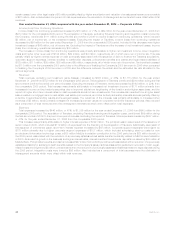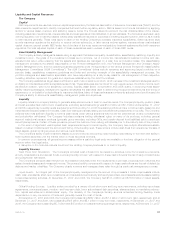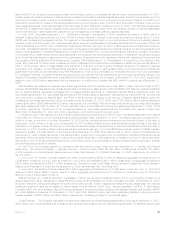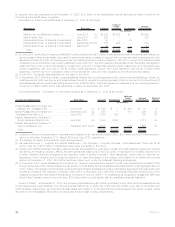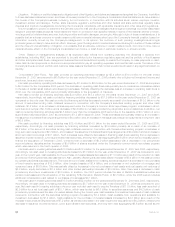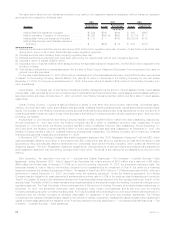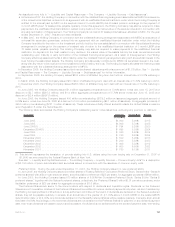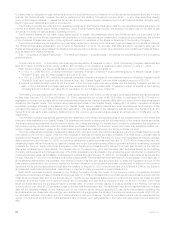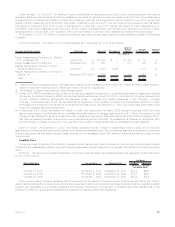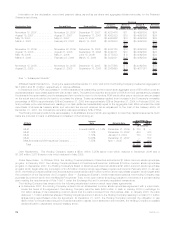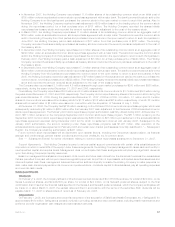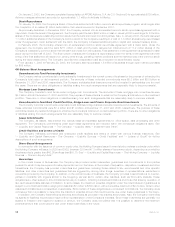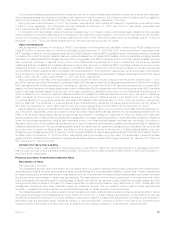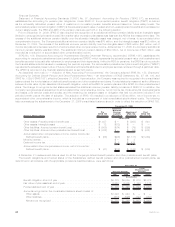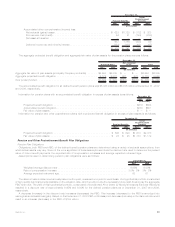MetLife 2007 Annual Report Download - page 55
Download and view the complete annual report
Please find page 55 of the 2007 MetLife annual report below. You can navigate through the pages in the report by either clicking on the pages listed below, or by using the keyword search tool below to find specific information within the annual report.
decrease in cash flow from operations of $1.4 billion. Cash available for investing activities was used to increase purchases of fixed
maturity securities, other invested assets, and short-term investments, as well as increase the origination of mortgage and consumer loans
and decrease net sales of real estate and real estate joint ventures and equity securities.
The Holding Company
Capital
Restrictions and Limitations on Bank Holding Companies and Financial Holding Companies — Capital. The Holding Company and its
insured depository institution subsidiary, MetLife Bank, are subject to risk-based and leverage capital guidelines issued by the federal
banking regulatory agencies for banks and financial holding companies. The federal banking regulatory agencies are required by law to
take specific prompt corrective actions with respect to institutions that do not meet minimum capital standards. As of their most recently
filed reports with the federal banking regulatory agencies, MetLife, Inc. and MetLife Bank met the minimum capital standards as per federal
banking regulatory agencies with all of MetLife Bank’s risk-based and leverage capital ratios meeting the federal banking regulatory
agencies’ “well capitalized” standards and all of MetLife, Inc.’s risk-based and leverage capital ratios meeting the “adequately capitalized”
standards.
The following table contains the RBC ratios and the regulatory requirements for MetLife, Inc., as a bank holding company, and MetLife
Bank:
MetLife, Inc.
RBC Ratios — Bank Holding Company
2007 2006
Regulatory
Requirements
Minimum
Regulatory
Requirements
“Well Capitalized”
December 31,
TotalRBCRatio .................................. 9.87% 9.89% 8.00% 10.00%
Tier1RBCRatio.................................. 9.56% 9.51% 4.00% 6.00%
Tier1LeverageRatio............................... 5.56% 5.55% 4.00% n/a
MetLife Bank
RBC Ratios — Bank
2007 2006
Regulatory
Requirements
Minimum
Regulatory
Requirements
“Well Capitalized”
December 31,
TotalRBCRatio................................. 12.60% 11.44% 8.00% 10.00%
Tier1RBCRatio................................ 12.03% 10.88% 4.00% 6.00%
Tier1LeverageRatio............................. 6.32% 5.98% 4.00% 5.00%
Liquidity
Liquidity is managed to preserve stable, reliable and cost-effective sources of cash to meet all current and future financial obligations
and is provided by a variety of sources, including a portfolio of liquid assets, a diversified mix of short- and long-term funding sources from
the wholesale financial markets and the ability to borrow through committed credit facilities. The Holding Company is an active participant in
the global financial markets through which it obtains a significant amount of funding. These markets, which serve as cost-effective sources
of funds, are critical components of the Holding Company’s liquidity management. Decisions to access these markets are based upon
relative costs, prospective views of balance sheet growth and a targeted liquidity profile. A disruption in the financial markets could limit the
Holding Company’s access to liquidity.
The Holding Company’s ability to maintain regular access to competitively priced wholesale funds is fostered by its current high credit
ratings from the major credit rating agencies. Management views its capital ratios, credit quality, stable and diverse earnings streams,
diversity of liquidity sources and its liquidity monitoring procedures as critical to retaining high credit ratings.
Liquidity is monitored through the use of internal liquidity risk metrics, including the composition and level of the liquid asset portfolio,
timing differences in short-term cash flow obligations, access to the financial markets for capital and debt transactions and exposure to
contingent draws on the Holding Company’s liquidity.
Liquidity Sources
Dividends. The primary source of the Holding Company’s liquidity is dividends it receives from its insurance subsidiaries. The Holding
Company’s insurance subsidiaries are subject to regulatory restrictions on the payment of dividends imposed by the regulators of their
respective domiciles. The dividend limitation for U.S. insurance subsidiaries is based on the surplus to policyholders as of the immediately
preceding calendar year and statutory net gain from operations for the immediately preceding calendar year. Statutory accounting
practices, as prescribed by insurance regulators of various states in which the Company conducts business, differ in certain respects from
accounting principles used in financial statements prepared in conformity with GAAP. The significant differences relate to the treatment of
DAC, certain deferred income tax, required investment reserves, reserve calculation assumptions, goodwill and surplus notes. Manage-
ment of the Holding Company cannot provide assurances that the Holding Company’s insurance subsidiaries will have statutory earnings to
support payment of dividends to the Holding Company in an amount sufficient to fund its cash requirements and pay cash dividends and
that the applicable insurance departments will not disapprove any dividends that such insurance subsidiaries must submit for approval.
51MetLife, Inc.



